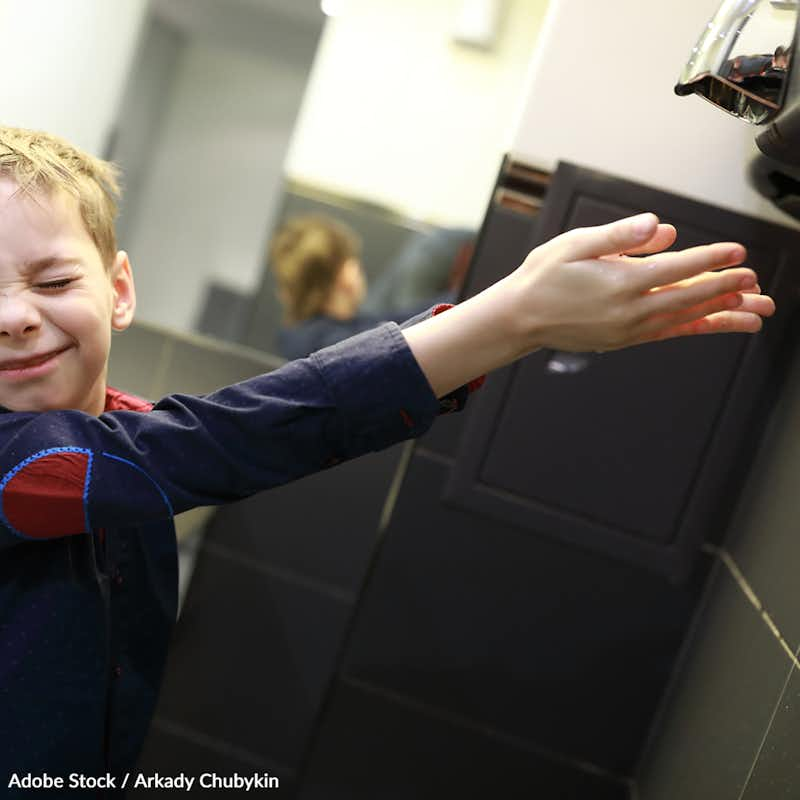Turn Down The Volume On Loud Hand Dryers
363 signatures toward our 30,000 Goal
Sponsor: The Autism Site
Loud hand washers make public restrooms a terrifying and painful experience for many. Take a stand!

Hand dryers in public toilets can be intolerably loud and painful to those on the autistic spectrum and with other special needs1.
The noise from these machines is loud enough to violate federal noise exposure standards, creating a traumatic experience that makes public toilets not an accessible amenity for children and adults2.
Most users are unaware of the pain they are about do endure when they enter a public restroom, with sometimes 5 or 6 dryers in a room operating at once3.
The unpredictable roar from a hand dryer starting up can be absolutely terrifying to some. When dryers are placed near entrance doors they can be accidentally activated on entering and can cause major distress.4.
One of the individuals who helped bring this fact to light was 13-year-old Nora Keegan5. Keegan's research on the sound coming from the hand dryers for a science fair project was published in the Canadian journal Paediatrics & Child Health6.
Keegan found that the Xlerator hand dryer, Dyson Airblade and Dyson Air Blade V machines were the loudest, operating at about 110 decibels. Just 10 decibels higher is enough to cause immediate pain to ears.
The Centers for Disease Control and Prevention maintains that noise at 85 decibels can cause hearing damage after a prolonged period of time7. The Occupational Safety & Health Administration (OSHA) of the United States recommends workers not be exposed to more than 90 dBA in an 8-hour shift8. The National Institute for Occupational Safety and Health (NIOSH) mandates that workers should not be exposed to more than 85 dBA in an 8-hour workday9.
It stands to reason we should not be regularly exposing this volume to children and individuals for whom such noises could cause great stress.
There are more than 3.5 million people in the U.S. currently living with Autism. Autistic or neurodivergent individuals see and hear the world differently than others10. They can also become overwhelmed or feel physical pain when loud or offensive environmental stimulation makes it difficult to communicate, which means public restrooms can be fraught with fear and anxiety11.
There is rarely a "one-size-fits-all" standard for public resources, but it is clear that loud hand dryers pose a risk to everyone.
Sign the petition and help us encourage new noise standards for public bathrooms so all Americans can use them in comfort.
- Jonathan Ratcliffe, Audiologist (22 May 2017), "Call to ban washroom hand dryers say the deaf."
- Bradley J. Fasulo, Muhammed J. Shand, Daniel H. Coelho, American Journal of Otolaryngology (JulyAugust 2020), "Too loud? Do powered hand dryers violate federal noise exposure standards?"
- Sharla Kostelyk, The Chaos and the Clutter (2022), "Surviving Public Bathrooms with a Child with Sensory Issues."
- The Dallas Morning News (21 September 2015), "For drying out loud: Noisy hand dryers cause issues for some."
- Meghan Holohan, TODAY (23 July 2019), "13-year-old publishes study showing that hand dryers are too loud."
- Nora Louise Keegan, Paediatrics & Child Health (June 2020), "Children who say hand dryers 'hurt my ears' are correct: A real-world study examining the loudness of automated hand dryers in public places Get access Arrow."
- National Institute for Occupational Safety and Health, The Centers for Disease Control and Prevention (6 February 2018), "Noise & Hearing Loss Prevention."
- Occupational Safety and Health Organization, United States Department of Labor, "Occupational Noise Exposure."
- National Institute for Occupational Safety and Health, The Centers for Disease Control and Prevention (1998), "Occupational Noise Exposure."
- Autism Society (26 August 2015), "Facts and Statistics."
- Intellectual Disability and Health, University of Hertfordshire (2021), "Sensory Modulation Difficulties in Autism Spectrum Disorders: A brief primer."
The Petition:
To the administrators of the Occupational Safety & Health Administration (OSHA) of the United States, National Institute for Occupational Safety and Health (NIOSH), Centers for Disease Control and Prevention (CDC), and U.S. Department of Health & Human Services,
The Centers for Disease Control and Prevention maintains that noise at 85 decibels can cause hearing damage after a prolonged period of time. As such, the Occupational Safety & Health Administration (OSHA) of the United States recommends that workers not be exposed to more than 90 dBA in an 8-hour shift, while the National Institute for Occupational Safety and Health (NIOSH) mandates that workers should not be exposed to more than 85 dBA in an 8-hour workday.
At 120 decibels, the human ear experiences instant pain. It stands to reason we should not be regularly exposing this volume to children and individuals for whom such noises could cause great stress.
Yet, many public bathrooms contain machines that generate blasts as loud as 110 decibels.
There are more than 3.5 million people in the U.S. currently living with Autism. Autistic or neurodivergent individuals see and hear the world differently than others. They can also become overwhelmed or feel physical pain when loud or offensive environmental stimulation makes it difficult to communicate, which means public restrooms can be fraught with fear and anxiety.
The developing ears of young children can also be severely impacted by the deafening noise from hand dryers, which can be positioned at eye level for some.
The noise from these machines is loud enough to violate federal noise exposure standards, creating a traumatic experience that makes public toilets not an accessible amenity for children and adults.
I implore you to implement new standards for public bathrooms that require an 85 decibel maximum volume for hand dryers. Anything less puts the health of millions of Americans at risk.
Sincerely,